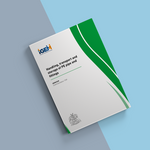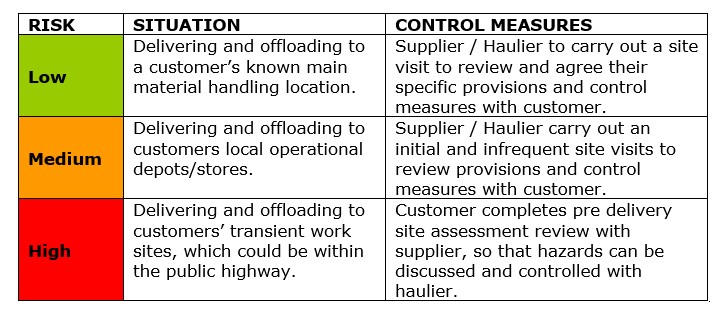IGEM/G/8 - Handling, transport and storage of polyethylene (PE) pipes and fittings

This standard covers the handling, transport, and storage of PE pipe and fittings in commercially available sizes. It covers PE pipe in coils, on drums and as straight lengths supplied either individually or as bundled packs.
This Standard is of a general nature to provide the minimum requirements for short term storage and the additional measures to be taken when components and assemblies are held for extended periods of time. The specific application will, therefore, need to take account of the particular circumstances involved and the components and assemblies that are being handled.
The contents are general to the wide range of components and assemblies available, and as such the specific application will need to take account of the specific circumstances and components involved.
The standard highlights precautions to control PE pipe products being delivered, offloaded and stored safely at customers’ sites. The underlying theme is that PE pipe products be treated with a similar level of caution as perceived heavier pipe products and be unloaded in a controlled and safe manner.
Introduction
1.1 Supplement 1 to IGE/TD/3 Edition 4 was issued in 2003 as Communication 1682, covering handling transport and storage of PE pipes and fittings.
IGEM/G/8 supersedes Communication 1682 which is obsolete.
1.2 This Standard has been drafted by the Institution of Gas Engineers and Managers' (IGEM) Gas Transmission and Distribution Committee, subsequently approved by that Committee and published by the authority of the Council of IGEM.
1.3 This Standard may be used in the handling, transport and storage of polyethylene (PE) components to be used in any fuel gas installation, such as those designed and installed in accordance with IGE/TD/3, IGE/TD/4, IGE/TD/13, IGEM/UP/2, etc.
1.4 In 2009, the UK Plastic Pipes Industry issued “Guidelines for the safe delivery and unloading of plastic pipes to customers’ sites” (see A2.7). These Guidelines received the written support of the Head of Injuries Reduction Programme, Health and Safety Executive (HSE). This Standard embraces the content of the Guidelines in terms of risk assessment, order placement, and receiving and unloading pipe deliveries. The opportunity has also been taken to update the Standard in terms of references, definitions, and prescription.
There is a common misconception that PE pipe products are lightweight and thus do not require the same stringent health and safety controls that are adopted for the handling of steel pipes.
This Standard highlights precautions to control PE pipe products being delivered, off-loaded and stored safely at customers’ sites. The underlying theme is that PE pipe products be treated with a similar level of caution as perceived heavier steel pipe products and be unloaded in a controlled manner.
A risk-based matrix has been developed below to describe the general dynamic nature of delivery and offloading at customers’ sites and the recommended control measures.

1.5 It is now widely accepted that the majority of accidents in industry generally are in some measure attributable to human as well as technical factors. People who initiated actions that caused or contributed to accidents might have acted in a more appropriate manner to prevent them.
To assist in the control of risk and proper management of these human factors, due cognisance should be taken of HSG48.
1.6 The primary responsibility for compliance with legal duties rests with the employer. The fact that certain employees, for example “responsible engineers”, are allowed to exercise their professional judgement does not allow employers to abrogate their primary responsibilities. Employers must:
- have done everything to ensure, so far as is reasonably practicable, that there are no better protective measures that can be taken other than relying on the exercise of professional judgement by “responsible engineers”
- have done everything to ensure, so far as is reasonably practicable, that “responsible engineers” have the skills, training, experience and personal qualities necessary for the proper exercise of professional judgement
- have systems and procedures in place to ensure that the exercise of professional judgement by “responsible engineers” is subject to appropriate monitoring and review
- not require “responsible engineers” to undertake tasks which would necessitate the exercise of professional judgement that is beyond their competence. There should be written procedures defining the extent to which “responsible engineers” can exercise their judgement. When “responsible engineers” are asked to undertake tasks that deviate from this, they should refer the matter for higher review.
Note: The responsible engineer is a suitable qualified, competent and experienced engineer or a suitably qualified, competent and experienced person acting under his or her supervision, appointed to be responsible for the application of all or part of this Standard.
1.7 This Standard makes use of the terms “must”, “shall” and “should” when prescribing particular requirements. Notwithstanding Sub-Section 1.8:
- the term “must” identifies a requirement by law in Great Britain (GB) at the time of publication
- the term “shall” prescribes a procedure which, it is intended, will be complied with in full and without deviation
- the term “should” prescribes a procedure which, it is intended, will be complied with unless, after prior consideration, deviation is considered to be acceptable.
Such terms may have different meanings when used in legislation, or HSE Approved Code of Practice (ACoPs) or guidance, and reference needs to be made to such statutory legislation or official guidance for information on legal obligations.
1.8 Notwithstanding Sub-Section 1.7, this Standard does not attempt to make the use of any method of specification obligatory against the judgement of the responsible engineer. Where new and better techniques are developed and proved, they should be adopted without waiting for modification of this Standard. Amendments to this Standard will be published when necessary and their publication will be announced in the journal of IGEM.
1.9 Requests for interpretation of this Standard in relation to matters within its scope, but not precisely covered by the current text, should be addressed, in writing, to Technical Services, IGEM, IGEM House, 26-28 High Street, Kegworth, Derbyshire, DE74 2DA, and will be submitted to the relevant Committee for consideration and advice but in the context that final responsibility is that of the engineer concerned. If any advice is given by or on behalf of the IGEM, this does not imply acceptance of any liability for the consequences and does not relieve the responsible engineer of any of his or her obligations.
1.10 This Standard was published in December 2010.
Scope
2.1 This Standard covers the handling, transport and storage of PE pipe and fittings in commercially available sizes.
2.2 This Standard considers PE pipe in coils, on drums and as straight lengths supplied either individually or as bundled packs.
2.3 This Standard is of a general nature to provide the minimum requirements for short term storage and the additional measures to be taken when components and assemblies are held for extended periods of time. The specific application will, therefore, need to take account of the particular circumstances involved and the components and assemblies that are being handled.
2.4 This Standard assumes the use of a metric PE pipe system and the term “diameter” refers to the nominal outside diameter of the pipe.
2.5 Italicised text is informative and does not represent formal requirements.
2.6 Appendices are informative and do not represent formal requirements unless specifically referenced in the main sections via the prescriptive terms “must”, “shall” and “should
